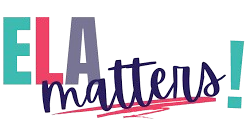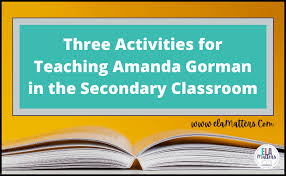One of my favorite genres to teach my students is poetry. It’s often short and wildly varied and I love that poetry allows authors to break all the rules of grammar, punctuation and convention to create something totally unique.
Some of my favorite authors to teach include Maya Angelou, James Baldwin, and William Carlos Williams.
But above all, I love to teach spoken word poetry.

What is Spoken Word?
Spoken word is a type of poetry that is meant to be performed rather than read off of a page. It is sometimes called slam poetry or performance poetry.
Why Spoken Word?
Many students get the idea that poetry is staunch and formal and difficult to understand. I love spoken word because it breaks down all of those expectations.
Spoken word is informal. It’s filled with conversational tones, everyday language, and sometimes even slang. It has a lyrical sound to it that makes it impossible to ignore.
It’s direct and assertive and it incorporates body language, facial expressions, varied tones, word play, and pregnant pauses.
Spoken word is dynamic and often incorporates more than one performer with coordinated readings.
And it’s powerful. Not just in the way spoken word poets address their topics of choice, but also as a tool for breaking down apathy in the classroom.
Spoken word is the one genre that leaves even my most tuned-out student suddenly sitting upright, not only listening to, but contributing to – or even driving – the class discussion.
Some of my favorite spoken word artists include Rudy Francisco, Taylor Mali, and Sarah Kay, but lately, Amanda Gorman has stepped front and center of the spoken word and slam poetry world.
Who is Amanda Gorman?
Amanda Gorman is an American poet who was chosen for Joe Biden’s 2021 inauguration. She is the youngest inaugural poet in US history and was chosen as the National Youth Poet Laureate in 2017.
I love teaching Amanda Gorman in my classroom because so many of my students see part of themselves in her: Gorman is a woman, a person of color, and someone who overcame a speech impediment to pursue a career in public speaking.
Gorman’s poetry focuses around issues of racial equality, diversity, and the power of poetry in politics for bringing social progress.
So here are 3 engaging ways to teach Amanda Gorman in your secondary classroom:
1. Share and discuss Gorman’s Ted Talk, “Using Your Voice is a Political Choice”
This video is a great way to start the poetry unit because Gorman’s speech is a powerful answer to the inevitable question: “why are we doing this and why does it matter?”
My students were really motivated to study poetry after watching this speech about the power of poetry and the larger impact poetry and writing can have on our world.
I play the video the first time without pausing or interrupting so that students can experience the speech the way it was intended instead of having to jump straight into analyzing it.
After the video finishes, I invite students to write for a few minutes about what they heard, what they were moved by or related to, what stood out to them, or anything they liked or didn’t like about the speech.
I give students the opportunity to share their ideas with a partner and then with the whole class if they’d like to.
After the discussion, I provide students with discussion questions and play the video again, this time pausing the video to give them time to reflect and answer.
Here are few of the questions I use with my students:
- Gorman begins the poem by sharing her mantra. A mantra is a motivating word or phrase that you can repeat to yourself during difficult times. Create your own mantra.
I find it helpful to provide students with an optional sentence frame, based on Gorman’s mantra: “I am the child of ___________________, who _________________ and __________________. I stand for ________________________________________________.”
- Immediately after Gorman shares about her difficulty speaking up as a child, she changes her speaking style from standard speech to spoken word, which is a form of poetry that is meant to be spoken or performed. What point does she make by doing this or what is the intended effect?
- Gorman states, “If I choose not to speak out of fear then there’s no one that my silence is standing for.” Who or what would you like to use your voice to stand for? Explain.
2. Analyze Amanda Gorman’s inaugural poem, “The Hill We Climb”
Gorman is probably best known for her poem “The Hill We Climb,” which she read at Joe Biden’s 2021 inauguration.
The poem conveys a powerful message about hope, unity, and our nation’s slow, sometimes painful path to social change and progress.
I found it useful to start with an annotation and close reading of the poem to help students gain a more complete understanding of the complex topics and language Gorman uses in the poem.
In my close reading guide, I include questions that lead students to examine Gorman’s use of irony, figurative language, and word choice in the poem.
For example, I asked my students to consider the difference between the meaning of the word “broken” and the word “unfinished” and I asked what it means to them that Gorman says our nation is not broken, but only unfinished.
After we finished our close read, I asked students to apply the rhetorical analysis skills we’ve been practicing all year to Gorman’s poem. students used SOAPSTone and graphic organizers to help them identify and analyze Gorman’s use of rhetorical appeals and rhetorical devices.
(If you need some help with this, you can find rhetorical analysis graphic organizers for Gorman’s poem here)
3. Hold your own poetry slam
Perhaps my favorite way to incorporate poetry into my classroom is to set up our own poetry slam in the classroom.
After students have a thorough understanding of Gorman’s poem, “The Hill We Climb” (see step 2 above), I decided to help them write their own slam poems to present and share with the class.
I started by guiding students to look specifically at Gorman’s use of sound devices in the poem to help them understand what techniques Gorman uses to give the poem it’s performative aspect.
We focused on her use of alliteration, paradox, and repetition, but there are several other sound devices at work in the poem students could analyze.
After students had an understanding for how sound devices can be used to transform a “regular” poem into a slam poem, they brainstormed topics for writing their own slam poems.
I decided to set the assignment up as a collaborative project, with students writing and performing the poem together in small groups.
Once the poems were finished, we had a class poetry slam in which students present the poems to the class as their audience.
Need a little more help?
If you’d like to check out some no-prep, done-for-you resources for these activities, you might want to check out this Amanda Gorman Activity Bundle, which includes resources for the activities outlined above and more.

